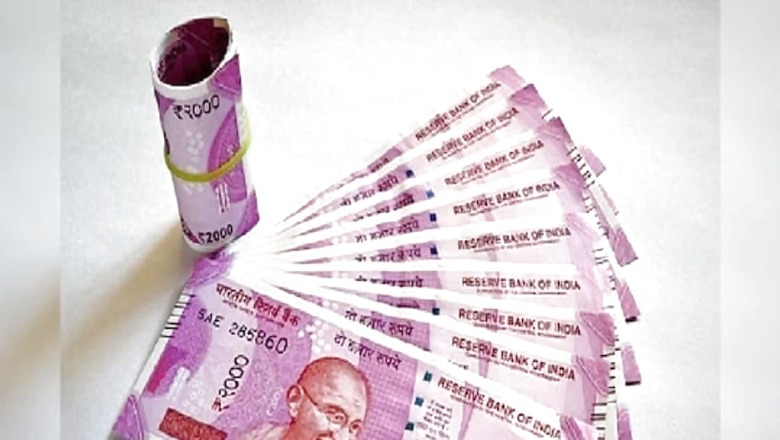
views
Why did the Reserve Bank of India (RBI) withdraw Rs 2,000 notes from circulation?
Explaining the move, the RBI said, “About 89 percent of the Rs 2,000 denomination banknotes were issued prior to March 2017 and are at the end of their estimated lifespan of 4-5 years. The total value of these banknotes in circulation has declined from Rs 6.73 lakh crore at its peak as on March 31, 2018 (37.3 percent of notes in circulation) to Rs 3.62 lakh crore, constituting only 10.8 percent of notes in circulation on March 31, 2023. It has also been observed that this denomination is not commonly used for transactions. Further, the stock of banknotes in other denominations continues to be adequate to meet the currency requirement of the public.” The Central Bank added, “In order to ensure operational convenience and to avoid disruption of regular activities of bank branches, exchange of Rs 2,000 banknotes into banknotes of other denominations can be made upto a limit of Rs 20,000 at a time, at any bank starting from May 23, 2023.” Additionally, the facility for the exchange of Rs 2,000 bank notes up to the limit of Rs 20,000 at a time will be provided at the 19 regional offices of the RBI.
Why was the Rs 2,000 note introduced?
As banknotes of smaller denominations became readily available, the requirement of Rs 2,000 notes was met and its printing was stopped in 2018-19 (FY19). It was introduced after the demonetisation exercise in November 2016, as it was the right step at that point, for various reasons.
How many Rs 2,000 notes are currently in circulation?
There are approximately 181 crore notes in the denomination of Rs 2,000. This amounts to a value of Rs 3.62 lakh crore, constituting about 10.8 percent of Indian currency notes in circulation. The number of banknotes of Rs 2,000 denomination has steadily declined over the last few years to touch 214 crore or 1.6 percent of the total currency in circulation (CIC) at the end of March 2022, according to the RBI. The total number of currency notes of all denominations in circulation stood at 13,053 crore as of March 2022, up from 12,437 crore from the year-ago period.
Do note that Rs 2,000 notes have not been printed since FY19. At the end of March 2020, the number of Rs 2,000 denomination notes in circulation stood at 274 crore, accounting for 2.4 percent of the CIC. The count of Rs 2,000 notes further declined to 245 crore or 2 percent of the total banknotes in circulation as of March 2021 and further fell to 214 crore or 1.6 percent at the end of last fiscal year. The limited point is, 2,000 rupee notes have been consistently and persistently declining in volume, as a percentage of total currency notes in circulation. It was the right time, therefore, for the Modi government, to announce the calibrated exit of these notes on March 19, 2023. In value terms also, the 2,000 denomination notes dipped from 22.6 percent of the total value of currency notes in circulation in March 2020 to 17.3 percent at the end of March 2021 and further to 13.8 percent at the end of March 2022. That figure in March 2023 is even lower, at barely 10.8 percent.
In volume terms, Rs 500 denomination constituted the highest share at 34.9 percent, followed by Rs 10 denomination bank notes, which constituted 21.3 percent of the total banknotes in circulation as on March 31, 2022.
The 500 denomination notes accounted for 31.1 percent share at the end of March 2021 and 25.4 percent as of March 2020. In value terms, these notes rose from 60.8 percent to 73.3 percent from March 2020 to March 2022. The total value of currency notes in circulation of all denominations rose to Rs 31.05 lakh crore at the end of March 2022, from Rs 28.27 lakh crore at the end of March 2021. In value terms, the share of Rs 500 and Rs 2,000 notes together accounted for 87.1 percent of the total value of banknotes in circulation as on March 31, 2022, as against 85.7 percent at the end of March 2021. The value and volume of banknotes in circulation increased by 9.9 percent and 5 percent respectively, during 2021-22 (FY22), as compared to 16.8 percent and 7.2 percent respectively, during 2020-21 (FY21.)
The CIC includes all kinds of banknotes and coins.
Now that we have all the relevant numbers as mentioned above, it will be easier to appreciate the reasons why the Modi government decided to have a calibrated exit for the Rs 2,000 notes. Before delving deeper, it is important to note that what happened on November 8, 2016, was the demonetisation of Rs 500 and Rs 1000 notes, whereby these notes ceased to become legal tender. While Rs 1000 notes ceased to exist, a fresh series of Rs 500 notes, replacing the old ones, came into play. However, what happened on May 19, 2023, is not demonetisation but simply a calibrated exit of the Rs 2,000 notes, because these notes continue to be legal tender.
State Bank of India (SBI), India’s largest public sector bank, has clarified that the facility of exchange of Rs 2,000 denomination bank notes upto a limit of Rs 20,000 at a time, will be allowed without obtaining any requisition slip, which means without any identity proof. Also note that while there is an upper threshold of Rs 20,000 on the exchange of notes at a given time, there is no upper cap on the deposit of these notes.
What are the advantages of this calibrated exit?
Well, first and foremost, phasing out of Rs 2,000 currency notes by the RBI would help ferret out a huge part of the Rs 3.62 lakh crore worth of Rs 2,000 currency notes that are in circulation. As we have seen in several raids, where mountains of currency stored using the Rs 2,000 note were uncovered, all these instances of hoarding of cash involved the Rs 2,000 note. As the use of the Rs 2,000 note as a medium of exchange has declined significantly, it is being used primarily to hoard money by the corrupt. Hence, the calibrated withdrawal will help nail the corrupt and make their ill-gotten wealth a part of the formal banking channels, on which they have to pay relevant tax rates. But if the corrupt choose to keep their pile of Rs 2,000 notes hidden, without depositing it in banks, then their hoarded wealth eventually will not be even worth the paper that the Rs 2,000 notes are printed on. So the choice for hoarders is to either pay tax on their hoarded wealth and still keep some wealth with themselves by legitimising it, or simply lose everything.
Again, the 80-20 rule suggests that 20 percent of the people hoarding the Rs 2,000 notes are likely to be hoarding/storing as much as 80 percent of the total value of these notes (Rs 3.11 lakh crore). The move will not inconvenience common people as the Rs 2,000 notes are not being used much in any case, as a medium of exchange. In fact, they currently constitute only 10.8 percent of the CIC. Again, digital payments are being used in a large number of economic transactions. So the role of physical currency notes, especially the Rs 2,000 note, as a medium of exchange has declined significantly. Additionally, the Rs 500 note could be used as a medium of exchange to substitute even the minimal use of the Rs 2,000 note. Digital transactions are expected to multiply 3x (three times) from now to 2026, thereby minimising the need for the Rs 2,000 note as a medium of exchange even more, in the coming years.
There are concerns that a four-month window to deposit or exchange 80 percent of the Rs 2,000 notes in circulation, amounting to Rs 3.11 lakh crore, may not be enough. Well, it is more than enough. What is the total number of bank branches? Approximately, 1.5 lakh. On average, each branch has to accept deposits or change just 2 crore worth of Rs 2,000 notes. There are roughly four months or about 80 working days, assuming a 5-day working week and banking-related national holidays in these four months. Each day, you need each branch to replace Rs 2.5 lakh or 125 notes of the Rs 2,000 note. This, in turn, translates into a 5-minute per day, per branch, average job. Even if you assume that only 30,000 branches in top cities actively exchange the Rs 2,000 notes, even then it is just a half-hour job per branch, per day, for the next four months.
There are many within the Opposition who have again started maligning the Modi government’s decision pertaining to demonetisation in 2016. They need to be reminded that in January 2023, the Supreme Court of India upheld the demonetisation move of the government in a 4:1 majority verdict. The majority, comprising Justices S Abdul Nazeer, B R Gavai, A S Bopanna, and V Ramasubramanian, held that the Centre’s notification dated November 8, 2016, was valid and satisfied the test of proportionality. Even the only dissenting voice, Justice BV Nagarathna, held that demonetisation was well-intentioned. The SC heard a batch of 58 petitions challenging the demonetisation exercise, before announcing its verdict, whereby the apex court underlined that the Modi government and the RBI worked in tandem and not in ‘isolated boxes’, as alleged by some. The majority view also placed reliance on the “record” submitted by the Central government after the hearing was complete and the SC held that the RBI was sufficiently consulted on the issue and that the Centre and RBI discussed the demonetisation issue for over six months. Hence, wild allegations by the likes of Rahul Gandhi and his acolytes, that demonetisation was a unilateral decision by the Modi government, proved to be false. Be it the decision about calibrated withdrawal of the Rs 2,000 notes in May 2023 or the demonetisation decision in November 2016,
the Central government under sub-section (2) of Section 26 of the RBI Act of 1934, has always used its powers for the greater good, with an aim to clamp down on black money and money hoarders.
The 4:1 verdict by the Supreme Court in the Modi government’s favour not only rejected the petitions challenging demonetisation but also upheld its legality, with the majority concluding that there was no flaw in the decision-making process. The apex court in its January 2023 ruling also stated that the Central government’s interpretation of the RBI Act is “pragmatic and not pedantic”, in a big jolt to the Opposition and virulent Modi naysayers. The Centre’s decision on demonetisation, on November 8, 2016, withdrawing the legal tender for Rs 500 and Rs 1000 notes “does not suffer from any flaws in the decision-making process” is what the SC effectively said in its January 2023 ruling. There were consultations between the Centre and RBI for a period of six months. There is a reasonable nexus to bring such a measure and it satisfies the test of proportionality. The decision-making process cannot be faulted merely because the proposal emanated from the Centre.
Ex-Finance Minister, P Chidambaram, had claimed that the dissenting verdict on demonetisation is a “slap on the wrist”, which is again false. There was no “dissenting verdict” but only a lone, dissenting voice of Justice Nagarathna. The demonetisation decision was upheld in both law and spirit by the SC via a 4:1 majority verdict and that is the only thing that matters, eventually.
Unusual deposits of Rs 1.7 lakh crore were seen during demonetisation, says an RBI paper. In nominal terms, excess deposits accruing to the banking system due to demonetisation are estimated to have been in the range of Rs 2.8-4.3 lakh crore. So demonetisation did achieve what it set out to do, by not only leaving a paper trail for erstwhile unaccounted deposits but also giving a massive impetus in formalising the economy and encouraging greater financialisation of savings, besides enlarging the tax base.
Massive searches, seizures and surveys by the Income Tax (I-T) department over the last three years led to the detection of around Rs 71,941 crore worth of “undisclosed income,” the Centre told the SC before it gave the 4:1 majority verdict. The biggest beneficiaries of demonetisation have been the poor due to digital transactions and the plugging of leakages through Direct Benefit Transfer (DBT). Over Rs 28 lakh crore has been disbursed to the poor via DBT. Demonetisation ushered in an unprecedented digital revolution in India. Transactions on the Unified Payments Interface (UPI) platform hit a new high of 890 crore transactions in April 2023. The value of these transactions stood at a new record of Rs 14.07 lakh crore. Meanwhile, FASTag transactions stood at 30.5 crore for a value of Rs 5149 crore.
Indeed, demonetisation has been one of the critical steps in the series of transformational economic policy steps and a major step to fight the menace of fake currency notes, storage of uncounted wealth and financing of subversive activities. All that said, the excellent decision to have a calibrated exit of the Rs 2,000 note is not demonetisation but simply a gradual withdrawal of the note. As these notes were not printed since FY19 and account for only a minuscule part of the overall CIC, this step will not inconvenience the commoner in any measure. Equally, it will flush out illegally hoarded wealth by those who amassed these Rs 2,000 notes, simply to circumvent paying taxes and to evade the institutional banking channels. As for the Opposition crying wolf, well, crying foul will not work simply because the calibrated withdrawal of the Rs 2,000 currency notes is a timely and wise move that will hold the commoner in good stead in the years ahead.
Sanju Verma is an Economist, National Spokesperson of the BJP and the Bestselling Author of ‘The Modi Gambit’.



















Comments
0 comment